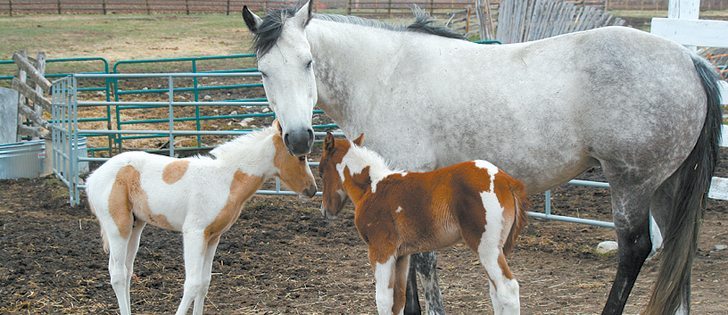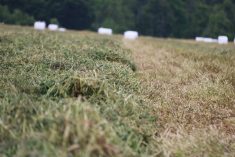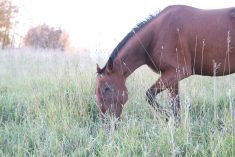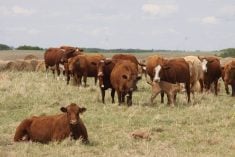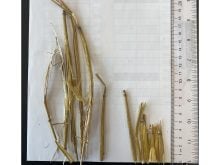LINDELL BEACH, B.C. — A strain of tall fescue known as Kentucky 31 has proven to be a hazardous forage grass for brood mares.
Pregnant mares that have grazed on this tall fescue grass, especially in their last months of gestation, have longer pregnancies, difficult births, still births, poor milk let-down, thickened placenta, difficulty breeding again after foaling and larger foals with a level of dismaturity, which means immature foals despite full-term pregnancies.
The problem lies in a microscopic endophyte fungus, Neotyphodium coenophialum, which lives symbiotically within the host grass. The endophyte helps the plant handle stress, making it more vigorous.
Read Also

Trump’s tariffs take their toll on U.S. producers
U.S. farmers say Trump’s tariffs have been devastating for growers in that country.
It is able to handle grazing pressure well, controls soil erosion when grown on hillsides and can tolerate drought conditions.
However, the endophyte also produces a toxic alkaloid that can cause toxicosis and has the ability to cause serious disorders in pregnant horses and cows.
Tall fescue is a cool season, perennial grass with broad leaves and prominent veins. It becomes bunchy when allowed to get too tall. When mowed for haying, fescue leaves will roll into tight cylinders during the curing period, making them hard to identify.
“Tall fescue (was imported) from Europe,” said Bob Coleman, a horse extension specialist with the University of Kentucky.
“The strain that causes the problem is called Kentucky 31 because it was found in Kentucky in 1931.”
The grass was seen growing on a steep hillside, which are hardy conditions for a plant.
Scientists believe that it now covers 35 million acres. It is common in the southeastern United States and parts of the Midwest and can grow in Oregon.
Some varieties of fescue grow in Canada but not likely Kentucky 31. Coleman said it’s grown from seed production as a turf type in some Peace River areas.
Tall fescue is found across the eastern half of the U.S. and in the Pacific Northwest. Estimates are that more than 90 percent of tall fescue pastures in the U.S. are infected with the fungus.
Tall fescue toxicosis causes problems in brood mares during their last third gestation. Coleman said the alkaloids produced by the endophyte fungus act on hormonal production, which affects progesterone, the key to parturition.
“In a lot of cases, you’ll find that the foals that are born are carried longer,” he said.
“Twenty plus days is not uncommon. They tend to have a level of dismaturity, which seems strange, as they have additional gestational age. Because of the impact on the hormonal balance, it’s not uncommon to start parturition, but without the hormonal cascade needed (for birth and milk production) from the mare’s perspective. So we see a lot of difficult births (distotia) and they can have a big foal. With distotia, there can be a significant loss of mares and foals.”
Tall fescue toxicosis also affects cows and can cause lameness and a chronic, unhealthy condition in summer. Cows can also suffer from fescue foot and fat necrosis.
“They get fescue foot,” Coleman said.
“It affects the blood flow. In pregnant beef cattle, it seems to be more of an impact on early gestation in cows rather than late gestation in horses.”
Fat necrosis is the development of hard fat deposits in the abdomen, which can interfere with digestion and parturition. While fescue foot and fat necrosis are thought to be relatively rare, fescue toxicosis is known across the southeastern U.S. and the Midwest. It is identified with rough hair coats, heat stress, suppressed appetite, poor growth and reduced calving rates.
Infected tall fescue can enter a horse’s diet from many sources. In addition to pasture containing fescue, the grass may be present in hay or bedding.
Avoiding this problem means preventing brood mares and pregnant cows from eating any infected fescue in the first place. This is particularly important for brood mares during the last 60 to 90 days of gestation. Remove them from pasture that may contain the grass, avoid feeding hay that may contain infected tall fescue and avoid bedding containing pasture clippings from a tall fescue source. Cured hay is just as toxic as live grass.
“The best method of removal is to spray it with a herbicide,” said Coleman. “There would need to be a minimum of two applications.”
He said some farmers will turn the pasture over to crop production. It’s not uncommon for corn to be grown and the land maintained through tillage.
However, one of the problems is that the endophyte is spread by the seed of grasses, so it gets into the soil. In regions where it is established, it comes back year after year as a stubborn perennial and farmers end up with a large natural seed bank.
The challenge with tall fescue is that there are both healthy and infected stands of the grass, but the two can’t be identified with the naked eye.
“That is typically why people just want to get rid of it,” said Coleman. “Horse people don’t want fescue, period. They don’t want to be bothered with it.”
Mares are safe from the toxicity if farmers are not growing the K31 variety of tall fescue, have never planted it and don’t have seeds for it. As well, the spread of the infected grass is minimal in field studies where pastures are divided by a fence, with infected plants on one side and healthy plants on the other.
However, Coleman said infected tall fescue is more vigorous and will likely overtake the pasture if gets into an otherwise healthy field.
Infected tall fescue can also affect non-pregnant horses. Yearlings grazing endophyte-infected tall fescue pastures have been shown to have reduced rates of growth compared to yearlings on alternative pastures.
Non-breeding mares and pleasure horses may tolerate endophyte-infected tall fescue pastures to some degree, but performance horses may be affected.
Studies found that horses ridden over rolling hills at a brisk trot for 30 minutes a day took longer to recover respiratory rates and skin temperature if they were grazing on infected fescue pasture.
Coleman advises brood mare owners not to take any chances and to get rid of tall fescue.
“If you have some hillsides hard to keep grass on, fescue will grow there. But don’t grow it where horses graze.”

